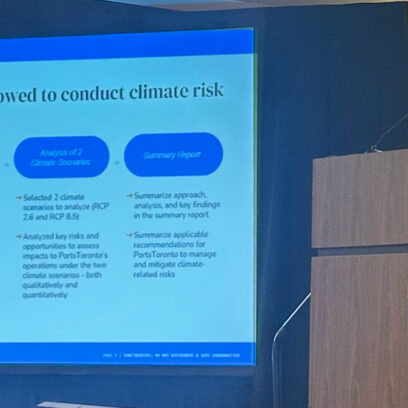The ROI of Sustainability


FW Sustainability Report
Learn more about how Fierce Whiskers has made sustainable choices every step of the way by downloading its full sustainability report.
Companies no longer have to choose between a financially responsible business model and an environmentally friendly one.
Fortunately, companies no longer have to choose between implementing a financially responsible business model and one that is environmentally responsible. Today these goals can—and should—be intertwined with one another. CarbonBetter’s area of expertise lies at the intersection of environmental impact and corporate strategy, developing solutions that will benefit both organizations and the earth. We know that what’s good for the planet is good for business, and in this post you’ll learn why that’s true as we explore ways businesses invest in sustainability and the return on investment—and impact—of those efforts.
Ways Businesses Invest in Sustainability
Investing in sustainability efforts can take many forms, from small daily actions in the office, like recycling or adding bottle refilling stations, to large-scale changes in product manufacturing or implementing carbon offsetting strategies. No sustainability journey looks the same—some organizations move from measurement of impacts to reduction efforts to reporting, while other organizations follow more non-traditional paths based on their goals, industry, and resources. While there are best practices in approaches, we encourage companies of all sizes to take steps toward a more sustainable future in any manner that’s currently accessible… Progress over perfection. Let’s explore two impactful ways businesses can invest in sustainability.
Sustainability Investment Option 1: Sustainability Reporting
Sustainability reporting is a primary way businesses of all sizes invest in sustainability. Reporting enables organizations to define their impact on the planet, and reports are often updated annually after a baseline first report is done. The first report is typically a greater effort and expense than updated follow-up reports in subsequent years.
Sustainability reporting frameworks, like Global Reporting Initiative (GRI), CDP, and Sustainability Accounting Standards Board (SASB), help guide organizations through measuring and reporting their impact in a standardized way while also defining the scope of the company’s goals. SASB has noted that businesses’ most crucial sustainability metrics are reducing carbon output, energy consumption, water usage, and waste.
CarbonBetter helps organizations select and implement the right reporting framework based on their industry and goals. Reach out today to get started.
Explore SolutionsFor increased transparency and reporting accuracy, carbon emissions in sustainability reports are categorized into three scopes, though not all organizations measure all types:
- Scope 1—direct greenhouse gas (GHG) emissions from combustion sources owned and controlled by the company
- Scope 2—indirect GHG emissions from the generation of electricity used by the company
- Scope 3—accounts for all other GHG emissions that are a consequence of the activities of the company but are not necessarily controlled by the company itself, including supply chain and corporate travel
Organizations and governments worldwide are working towards net-zero goals by measuring, reducing, and reporting on Scope 1, 2, and 3 carbon emissions. Survey findings have shown that roughly 80% of N100 companies across the world report on sustainability, with 65% of those companies disclosing carbon reduction in their reports. While reporting on sustainability and carbon emissions is not mandatory for a majority of businesses within the US, pressure from consumers and investors has led some companies to address their environmental impacts proactively.
Organizations that are not required to measure and disclose their impacts can issue voluntary sustainability reports to disclose carbon, water, and waste impacts while potentially reducing risk, increasing margins, and delivering financial growth as a result of that work. As a strong signal for support of organizations that make environmental efforts, US ESG (Environmental, Social Governance) funds doubled from 2019 to 2020, with $51.1 billion of net-new money from investors.
“No sustainability journey looks the same—some organizations move from measurement of impacts to reduction efforts to reporting, while some organizations follow more non-traditional paths based on their goals, industry, and resources.”
Ways businesses invest in sustainability
Businesses that make vague and insubstantial sustainability claims fall short for investors and consumers looking for quantitative insights and reports regarding a company’s sustainability practices, which are provided in high-quality sustainability reporting.
Sustainability Investment Option 2: Reducing Impacts & Carbon Offsetting
Once a company’s impact baseline is measured, goals can be set, and reduction efforts can be tracked and measured over time. Depending on the business type and operational model, organizations have many options for reductions. There can be co-benefits associated with impact reduction projects, including increasing supply chain resilience, reducing the risk associated with high-impact processes, and lowering costs through more efficient processes.
For example, a whiskey distillery may focus on water usage improvements and locally sourcing ingredients to limit emissions associated with distribution, or a retail energy supplier may offset the energy supply provided to their customers and limit emissions from commutes through a remote workforce. Companies that use third-party manufacturing can work with their external partners to reduce or repurpose waste byproducts from manufacturing or improve energy sources.
For environmental impacts that are more difficult to reduce, companies can turn to the carbon markets to purchase carbon credits that can be retired to offset their emissions. Carbon offset projects allow companies to reduce their total carbon emissions today while continuing to work towards reducing their impacts from carbon, water, and waste now and in the future.
Participating in the carbon market can feel daunting on its own but CarbonBetter acts as a guide to help companies buy and retire high-quality carbon credits at the right price.
Learn More About OffsettingCarbon credits are issued by carbon offset registries which keep track of available offsets and track the retirement of purchased credits. Carbon offset registries also develop standardized protocols for different project types and technologies, ensuring the carbon credits are 3rd-party verified and have proven additionality. Registries act as a third party between buyers and project developers, helping ensure the promised environmental impact is met with clear and transparent metrics and that the retirement of each credit can only happen once.
Each carbon credit equals one ton of carbon emissions abated, which offsets one ton of carbon emitted by the purchaser when retired. When carbon emitted = carbon offsets retired, the retiring organization has balanced the net-zero equation. Net-zero emissions are a worthy goal, but it does not consider waste and water impacts, so it should be part of a larger sustainability strategy.
The simplest way to buy carbon credits is through CarbonBetter Certified Offset Portfolios, which allow buyers access to four hand-vetted projects in one simple transaction with CarbonBetter. Rather than spending time searching for high-quality carbon credits, CBCO Portfolios offer a mixture of carefully selected projects that can be purchased and retired in any quantity.

SUSTAINABILITY REPORTING OVERVIEW
Sustainability reporting serves as a valuable tool to achieve corporate commitments and better manage climate-related business risks. This white paper walks you through what's typically included and what should be considered.
Sustainability ROI: Return on Impact & Investment
Below is a summary of what different tools can do and where a 3rd-party like CarbonBetter may add value, whether you’re using software or spreadsheets.
Investing in Sustainability Can Reduce Operational Costs
Sustainability practices can reduce a company’s operational costs through supply chain optimization and reduced energy consumption and expenditures. Examining the entire supply chain and production processes can help companies identify where to cut back on certain resources and where switching to a cleaner and greener alternative is a cheaper option. A more optimized supply chain can help reduce the amount of energy consumption, reduce overall cost of production, and increase profit margins.
Investing in Sustainability Can Reduce Risk
Investing in a more sustainable business model can also help companies add value while reducing risk throughout the company.
Implementing sustainable practices is instrumental in proactively addressing issues that face current or future regulation. Being proactive about regulatory compliance helps reduce the risk of litigation throughout the life of the company.
Diversified renewable energy—such as power from wind, water, and solar—provides a company with greater energy security. Carbon-based energy sources, such as coal, are prone to drastic price fluctuations while the price of clean energy remains more stable.
Companies can also benefit from routine sustainability reporting by gaining detailed insights into how they are performing. Regular reports can help highlight issues that may have gone unnoticed until an obvious or irreversible problem arose.
Investing in Sustainability Can Increase Brand Value, Market Share, & Revenue
Sustainability measures work to directly increase brand value, market share, and support revenue growth.
Consumers are drawn to companies that care about the planet with brand values that align with their own values. A Nielson study revealed that 78% of consumers say that a sustainable lifestyle is important to them, making the case for why companies directly benefit from investing in sustainability.
The NYU Sustainability Market Share Index 2021 Report found that products marketed as sustainable now hold a 17.0% market share, an increase of +3.3 ppts vs. 2015. During the pandemic, products marketed as sustainable continued to see significant growth in market share.
Embracing a sustainable business model can financially benefit a company as sustainable practices help to elevate a brand, attract new customers and improve customer loyalty, correlating to a growth in revenue.
Investing in Sustainability Can Increase Brand Value, Market Share, & Revenue
Sustainability efforts have the potential to benefit the people directly involved in the company. From investors to employees to consumers, there lies an increased desire to support and work for companies that are working to minimize their impact on the planet.
In recent years there has been an increase in investor demand for ESG funds. In 2021, sustainable investing saw assets estimated to grow to $50 trillion by 2025. In 2018 alone, the number of sustainable investment funds increased by nearly 50%, and continues to grow with each passing year. These sustainable funds have had record-setting net flows, with 63% of them finishing out the year in the top half of their respective categories, showing both increased demand and better returns for investors.
In a recent survey, the clean energy company Swytch highlighted the importance of employees' desire to work for a sustainable company. Nearly 70% of employees reported that the company’s sustainability program has influenced their decision to stay at the company long-term. The same survey also reported that roughly 75% of millennials were willing to take a pay cut if it meant they could work for an environmentally responsible company. In the next five years, millennials will make up three-quarters of the workforce, which is why listening to their desires can have a direct impact on employee attraction and retention.
Consumers are also concerned about the sustainability practices of companies. A NielsenIQ report on consumer insights found that 45% of surveyed consumers rated climate change as a high concern. The same survey found that 37% of consumers feel that companies should reduce the amount of CO2 emitted in order to be deemed truly sustainable. NYU Sustainable Market Share Index found that sustainable products grew 2.7x faster than non-sustainable products, garnering a six-year CAGR of 7.3% compared to 2.8% for their non-sustainable counterparts. Consumers have become increasingly interested in purchasing products from companies that invest in sustainability and showcase how their business cares for the planet.
Conclusion
Businesses have many options when it comes to investing in sustainability, and many of those options can deliver significant ROI (return on impact and investment) through co-benefits like risk reduction, increased loyalty, revenue growth, and cost reduction. With so many options, the path forward may be unclear—that’s where CarbonBetter can help. The CarbonBetter Climate Services team helps organizations from the first step of a sustainability journey to scaling a long-standing program. Our expertise lies at the intersection of environmental impact and corporate strategy, and we offer a boutique, personalized experience with specialized services focused on building a net-zero future.
Businesses can invest in sustainability in several ways, including measuring and reporting on carbon, waste, and water impacts, as well as reducing impacts and offsetting harder-to-abate emissions. There are many ways to approach sustainability in business, and the right partner can help ensure that the steps taken align with budgets, goals, and resources.
Sustainability investments deliver both a return on investment and a return on impact in several key ways. Investing in sustainability can reduce operating costs; can reduce risks associated with supply chains, energy pricing volatility, and regulatory changes; can increase market share and brand value which boosts revenue; and can increase stakeholder engagement inside and outside of the organization. The key to maximizing impact and investment is finding the right partner to help create and execute a sustainability roadmap.
There are voluntary and regulatory drivers that drive businesses to invest in sustainability. Not only are there current and forthcoming regulatory requirements that businesses need to follow and consider, but voluntarily investing in sustainability can deliver several positive outcomes, including an improved bottom line. Sustainability investments can increase customer reach and customer loyalty, reduce risks within the business, and drive down operational costs.

About the Author
Pankaj Tanwar is Managing Director of Climate Services at CarbonBetter. He has experience leading Fortune 100 companies through their sustainability journeys, including sustainability driven growth in the food industry. Pankaj holds an MBA from Northwestern University’s Kellogg School of Management and a BTech in Mechanical Engineering from the Indian Institute of Technology, Kanpur.



